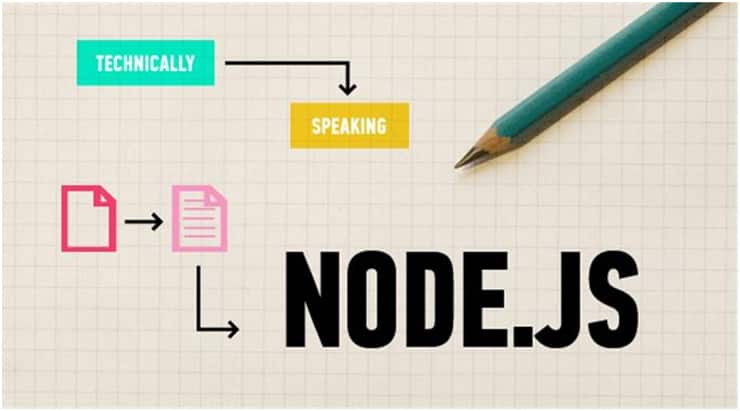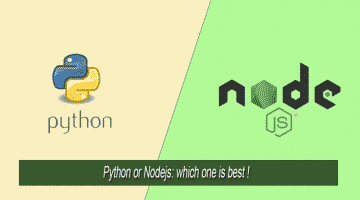Node.js is a JavaScript runtime built on Chrome’s V8 JavaScript engine. Node.js uses an event-driven, non-blocking I/O model that makes it lightweight and efficient. Node.js is an open-source, cross-platform JavaScript runtime environment for developing a diverse variety of tools and applications. The Node.js is not a JavaScript framework, but many of its basic modules are in JavaScript, and developers can also write new modules in JavaScript. The runtime environment interprets JavaScript using Google’s V8 JavaScript engine.
The Node.js a distributed development project. Ryan Dahl first wrote it in 2009. It allows the creation of Web servers and networking tools using JavaScript and a group of modules that handle the core functionality. The freelance gigs and Startups have quickly acquired these skills to get immediate benefits in their development.
The Node.js was built on the Google V8 JavaScript engine since it was open-source under the Berkeley Software Distribution (BSD) license. As the JavaScript was a well-known language, making Node.js immediately accessible to the entire web development community was very easy.
Defining a real-time application (RTA)
RTA is an application program that functions within a time frame that the user senses as immediate or current. The latency has to be less than a defined value, usually measured in seconds. The use of RTAs in your applications is called the Real Time computing (RTC).
Examples of RTAs are:
• The Videoconference applications which are available with specific hardware
• Voice over Internet Protocol (VoIP) used with telephone instruments and internet calling services
• Online gaming or network gaming apps
• Community storage solutions where the data is always updated
• Some e-commerce transactions like stock broking, where the online data is extremely important, which is always changing
• Chatting apps are very famous, and we will see an example at the end of this article
• IM (instant messaging) apps like WhatsApp
Why use Node.js for Real Time Application development?
1. Fast and Scalable: You can use it to create the network applications as the JavaScript execution is fast. The single threaded model with event loop is very helpful and allows handling multiple client requests. It is one of the major advantages of using Node.js for web applications.
2. Sharing and reusing: It is all fine to share packages of library code. If a developer faces any problem, the Node Package Manager (NPM), with its repository of more than 50,000 packages, helps the developer with the solutions. Updating, sharing and reusing of code are much easier now.
3. Streams in Node.js: As Node.js is event-driven, tackling of I/O bound tasks are extremely good. The streams are UNIX pipes which make it easy reading the data from the source and pipe it to the destination.
4. Data sync between client and server: Data transfer between the client and server happens fast because Node.js enables writing JavaScript on both client and server side.
5. Event based server: An Event-based & non-blocking driven server are best suited if the web applications get to handle a large number of real-time users.
6. Different modules: Availability of file system I/O, networking binary data, data streams and other functions is important. Node.js’s modules use an API designed to reduce the complexity of writing server applications. These applications can run on MacOS, Microsoft Windows, NonStop, and UNIX servers.
7. Differentiation with PHP: Node.js is primarily used to build network programs such as Web servers. The biggest difference between Node.js and PHP is that most functions in PHP block until completion while functions in Node.js are designed to be non-blocking. Node.js has brought event-driven programming to web servers. The freelance web designer community is using Node.js for a long time.
Node.js Frameworks
With the arrival of Node.js, JavaScript has come to the forefront of latest development. It is bound to happen since it is already a famous programming language used by developers in browsers. The Node.js is now offering one of the best solutions to building servers and web/mobile applications. It’s a single-threaded event looping and asynchronous, non-blocking input/output processing feature distinguish it from other runtime environments.
Its scope is rapidly increasing with valuable contributions from the freelance web developer community and other technology giants. Several performance-driven frameworks are currently developed using the basic principles and approaches of Node.js. These frameworks helped to extend the Node.js functionality and build newer features. There are more than 10 active Node.js frameworks.
Create simple RTA (a chat application) using Node.JS, Express.JS, and Socket.IO
If you decide to create a simple chat application using Node.js, you additionally need Express.js framework and Socket.IO library. Let us see how they can help and then we’ll see an example of creating a chat application.
Express.js: It is a framework of Node.js that allows you to use several powerful features which help you to organize your application’s routing and use any templating solution with easily. It also allows better organization of your code. This framework extends the core functionality of Node.js.
Socket.IO: It is the main JavaScript library for using with real-time web applications. It helps developers to establish a real-time, bi-directional connection between web clients and server. The client-side library runs in the browser and the server-side library for node.js. Both components have similar API & like node.js, it is also event-driven. Socket.IO provides the ability to implement real-time analytics, binary streaming, instant messaging, and document collaboration.
Example: Quick steps to create an online chat application using Node.js
• Now open NodeJS command prompt/terminal and navigate to your application directory i.e. chat-application.
• Create a package.json file which is the manifest file that describes our project.
• Install Express, HTTP, socket.io and path npm modules in your working directory i.e. chat-application.
• Create an HTML file index.html which is used to serve the chat window in the browser.
• Create a CSS file i.e. style.css to design the chat window.
• Next step is to create an index.js file that will setup our application on the server.
• Now create file for client side script i.e. chat.js
• Go to your web browser and open link in two different windows. Your chat application is ready!



